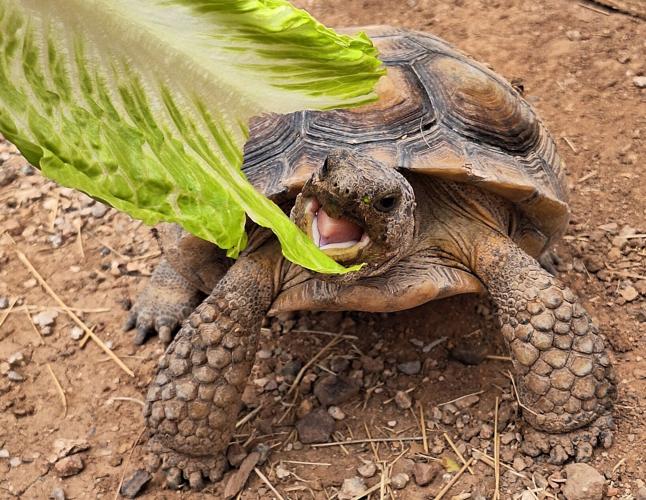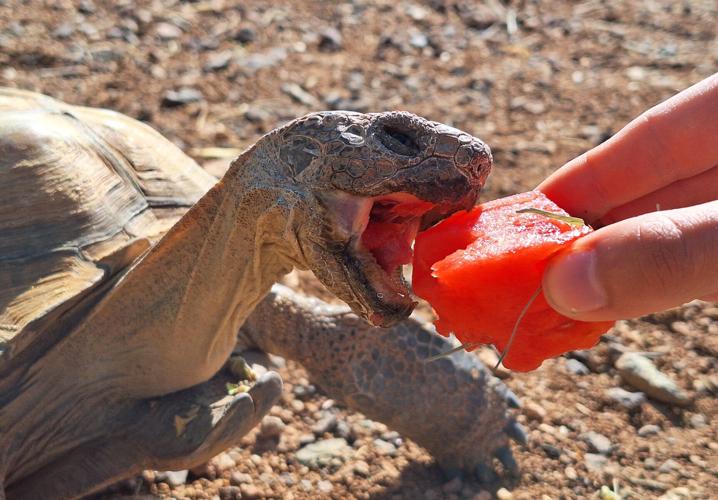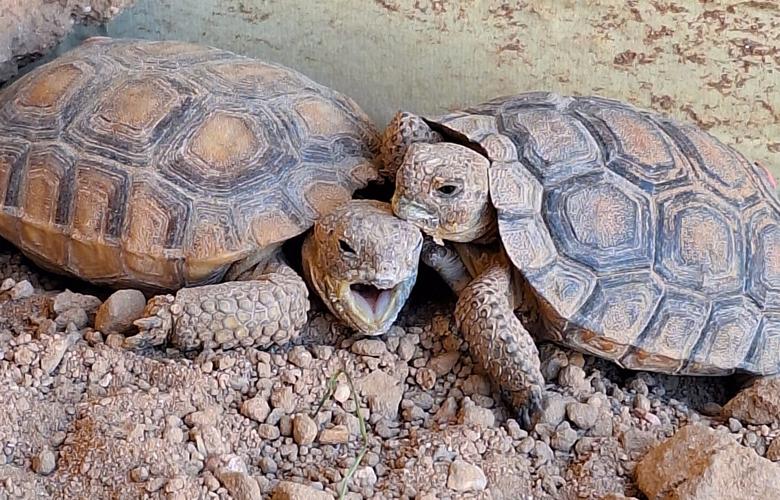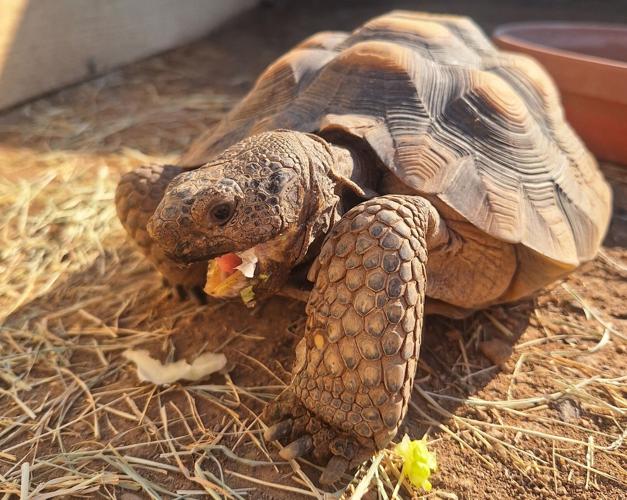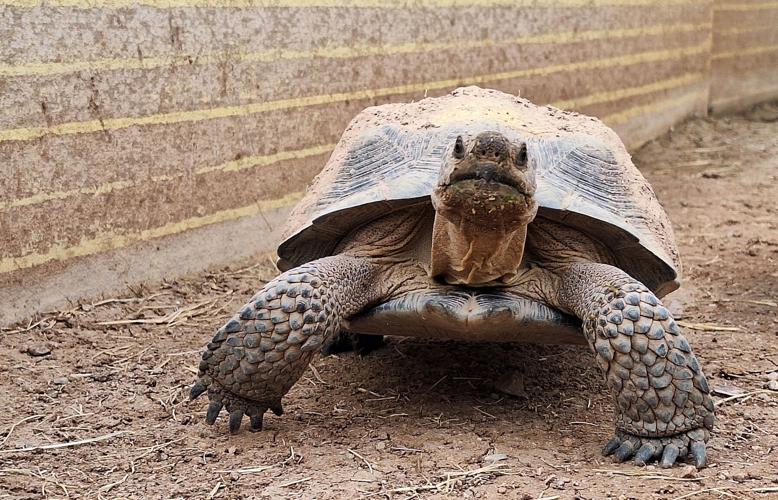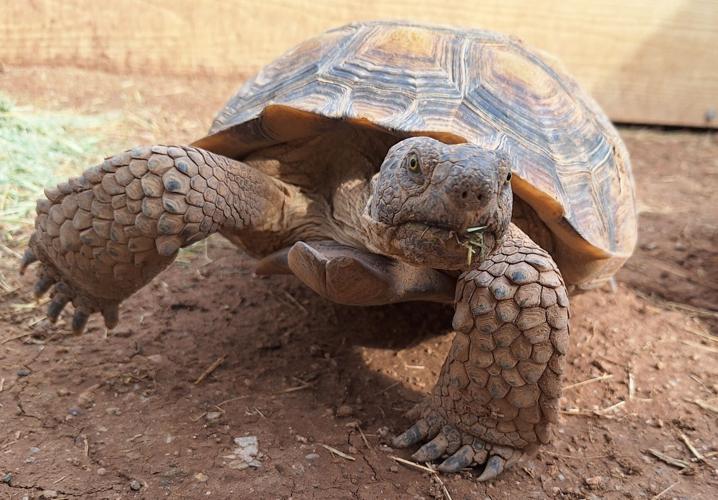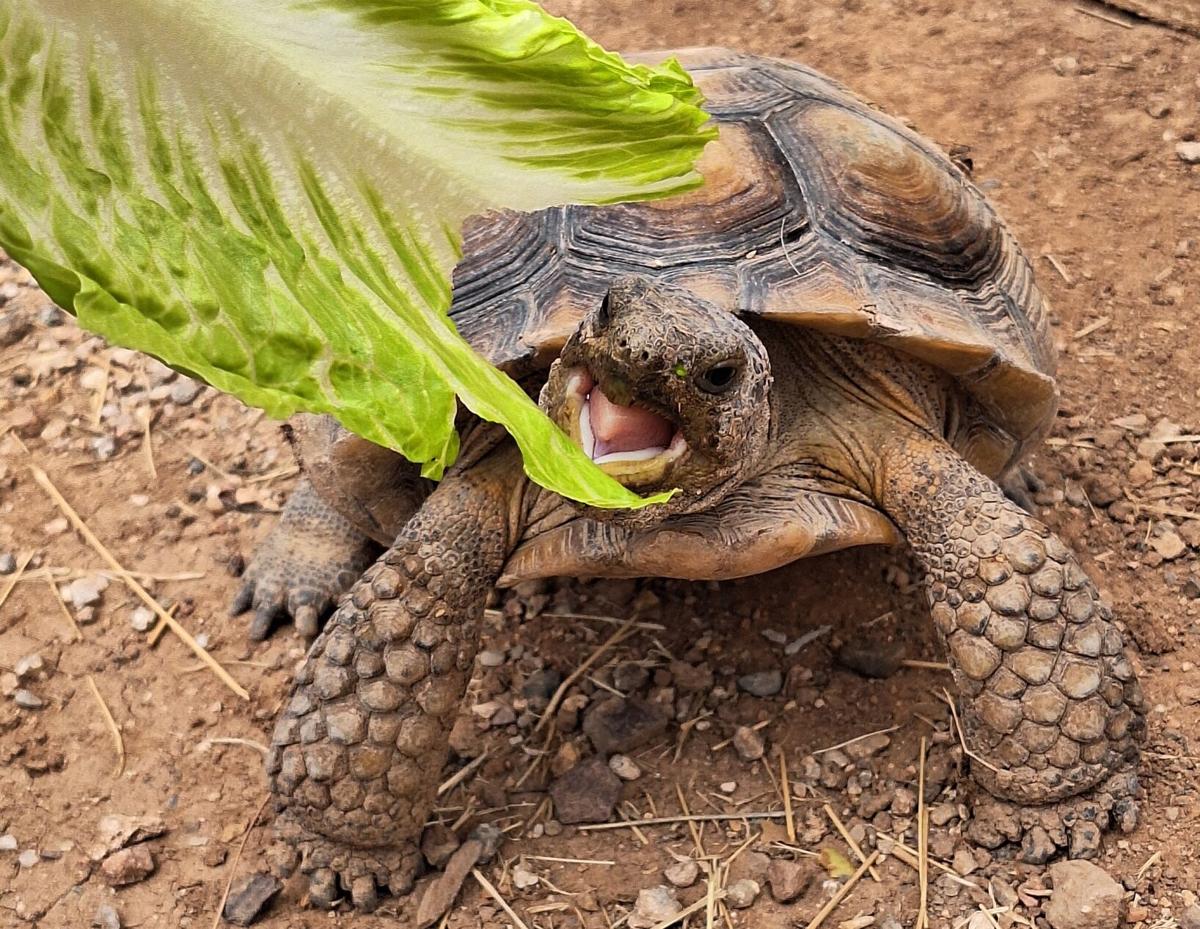Sonoran Desert tortoises (Gopherus morafkai) are a cool native animal. They are native to the Sonoran Desert and can be found anywhere in that region, including down to northern Mexico. They can live an incredibly long time — 50 to 80 years — and take about 15 years to reach sexual maturity. They grow up to about 14 inches in length.
They are not often spotted because they spend much of their lives either hiding in underground burrows from the heat or, when it’s cold, brumating underground (brumation is similar to hibernation, but is the term used for reptiles rather than mammals). They are most active in the spring and late summer.
Desert tortoises are herbivores, which means they eat only plants. This is where your garden comes in. If you have an open yard without walls or fencing, you can entice wild tortoises by planting the food they like to eat.
You can also adopt a tortoise from Arizona Game and Fish. These captive tortoises are seized from illegal breeding operations and cannot be released back into the wild because they carry diseases that could decimate the wild tortoise population. Captive tortoises may not have learned to forage properly, either. For these reasons, Game and Fish has about 70 captive Sonoran Desert tortoises which can be adopted.

Thanos is a Sonoran desert tortoise available for adoption from Arizona Game and Fish. Watermelon is a treat, but captive tortoises should mostly be fed native plants.
Sofia Langran of Arizona Game and Fish says they require an enclosure of 324 square feet minimally for adults (about 18 by 18 feet) and about 64 square feet for juveniles. Tiny baby tortoises need only 16 square feet but the enclosure must have some type of protective roof covering to keep predators away.
“Hatchlings are so small they're prey to birds, so they need that roof to prevent the birds from going in and swooping the hatchlings out. But as they get older, they're too heavy for the birds to pick up,” says Langran. She has approved smaller adult enclosures in the past if the environment is appropriately enriched.
Caretakers don’t necessarily need a separate enclosure in their yard. This is only required if you have another pet or other threats (like swimming pools or ponds) which can pose a problem for the tortoise. If your yard is deemed safe for tortoises and you don’t have other animals, the tortoise can have the run of your whole yard.
Langran encourages gardeners to plant lots of native plants for their tortoises to eat. “If you have the means to do a whole native plant jungle in your backyard, that's the best possible situation that a desert tortoise can have, because they'll eat their fill,” she says.
Native plants are healthier for tortoises than exotic foods, like lettuce, although she says many of the tortoises she looks after at AZGF really love the stuff. Langran recommends a good variety of native plants, so the tortoises get all of the nutrition they need. If you have enough plants, you can get to a point where you don’t need to feed your tortoise and they can look after themselves if you leave town for a week or so, which makes them a great low-maintenance pet.

These two Sonoran desert tortoise babies are available for adoption. Tortoises generally prefer to be solitary.
Langran recommends an area of about 9 square feet of mature native plants to feed your tortoise, although she says that will depend a great deal on the size of your tortoise and their individual appetites. “I've had people (build) a raised garden bed and then have a slope going down into the enclosure, so the tortoise can basically go up and down to eat the plants whenever it wants to.” The tortoise poop fertilizes the plants, and their munching stimulates plant growth, Langran says.
Native plants for tortoises
Tortoises eat a large variety of native plants. Don’t use herbicides or pesticides on any of the plants you feed your tortoise. You can feed them plant material from outside the enclosure as long as it hasn’t been treated. Arizona Game and Fish recommends using native plants in your yard, and advises homeowners to avoid planting any species that might become invasive. Large selections of locally grown plants with minimal pesticide exposure can be found at Spadefoot Nursery, Desert Survivors, and Tohono Chul’s Desert Corner Nursery.
A great time to plant for your tortoise is the fall, when they are not eating much and preparing to brumate. This gives plants some time to establish and grow larger before tortoises start munching on them. Tortoises usually eat a lot in the spring after they emerge, so keep an eye on how much they’re eating and whether you need to protect any plants.
If you’re planting for wild tortoises, you will need to protect young and smaller plants from excessive browsing by bunnies, deer and javelina. The best way to do this is to install temporary plant cages made from wire fencing or hardware cloth. You can also get pre-made plant cages. Once the plants are larger, you can remove the protection.
Trees
Native trees like mesquites, palo verde and desert willow not only provide shade but also leaves for mulch and flowers for eating, particularly if their branches are low. Desert willow is particularly recommended.
Cacti
They like eating cactus fruit, such as saguaro and prickly pear, but these should not be planted in the enclosures according to Arizona Game and Fish since their spines can be dangerous in an enclosed space. If you have native cacti outside your tortoise enclosure, you can pick fruit for your tortoise and offer it during the summer.

Sonoran Desert tortoise Nayla is munching on lettuce. She is available for adoption through Arizona Game and Fish.
Grasses
Tortoises really like to eat grasses, and there are a number of native grasses you can plant for them. These grasses generally like full to part sun and require some supplemental watering.
- Arizona cottontop (Digitaria californica)
- Bamboo muhly (Muhlenbergia dumosa)
- Blue grama (Bouteloua gracilis)
- Deer grass (Muhlenbergia rigens)
- Sideoats grama (Bouteloua curtipendula)
- Threeawn (Aristida spp.)
Vines
Vines are great because they’re generally fast-growing and produce lots of leaves. Most like partial shade. Many vines are winter-deciduous, but that’s fine for tortoises since they will be napping then. Some perennial native vines you can plant are:
- Arizona grape ivy (Cissus trifoliata): fast grower
- Native passionflower (Passiflora spp.): moderate grower
- Snapdragon vine (Maurandya antirrhiniflora): fast grower
Small shrubs
These are great for munching. Younger tortoises like their leaves. They are all perennials that prefer full to part sun.
- Daleas (Dalea spp.): fast grower
- Fairy duster (Calliandra eriophylla): slow grower
- Flattop buckwheat (Eriogonum fasciculatum): fast grower
- Globe mallow (Sphaeralcea spp.): moderate grower
Larger shrubs
These are also perennials, and grow larger. Tortoises browse on lower branches and eat flowers, fruit and seeds that the plants drop. They also love the cover these plants provide. Most of these, except the desert lavender, are fast-growing and all of them like full to part sun.
- Chuparosa (Justicia californica)
- Creosote bush (Larrea tridentata)
- Desert honeysuckle (Anisacanthus thurberi)
- Desert lavender (Condea emoryi)
- Arizona yellow bells (Tecoma stans)
Wildflowers
These are frequently annuals but some are perennials; some flower in the spring and some during the monsoon. They tend to prefer full sun and may need supplemental water during hot, dry spring or summer weather. Sow or plant some of each; the annuals will tend to re-sow themselves.
Annuals
- Lupines (Lupine spp.)
- Summer poppy (Kallstroemia grandiflora)
- Dogweed (Thymophylla pentachaeta)
Perennials
- Desert senna (Senna covesii)
- Penstemon (Penstemon spp.)
- Evening primrose (Oenothera spp.)
This list is abbreviated. For a larger plant list and lots more information, check out the Arizona Game and Fish brochure “Native plants for desert tortoises”.

Gigi is a captive Sonoran desert tortoise looking for a home. Captive desert tortoises are illegally bred and cannot be released into the wild.
Other considerations for tortoise caregivers
Tortoise caretakers also need to provide shallow water dishes for their tortoises with water available twice a week. If water is available all the time, Langran says tortoises can develop bladder stones, which are extremely uncomfortable and may eventually require risky surgery.
If you adopt a tortoise, you will need to build a burrow for it to brumate in the cold months, usually October to March, although this may extend depending on the weather. The burrow is an underground structure which is insulated from the cold and protected from predators. Game and Fish offers detailed instructions on constructing a tortoise burrow on their website.
Langran cautions that other animals like to hang out in tortoise burrows.
“Sometimes tortoises will share their burrows with other animals; it doesn't seem to bother them and the other animals don't seem to view the tortoises as a threat (but) rattlesnakes are one of those animals. So my recommendation to people who have tortoises would be don't go sticking your hands in the burrow willy-nilly, because something might surprise you one day.”
Bunnies, birds, insects and other critters can also hang out in the safety of the burrow. Burrowing squirrels can be a nuisance, and even a danger, according to Langran. “I've heard of some stories where the squirrels end up digging the burrow and it collapses on the tortoise. So if you do see ground squirrels with your tortoise just kick them out,” she says.
Because of their long lives, Sonoran Desert tortoises usually end up getting multiple owners throughout their life. If you’re not able to care for your tortoise anymore, you are required by law to surrender it back to Arizona Game and Fish. Langran says one of the reasons they have so many tortoises, particularly adults, available for adoption is because people have certain expectations of animals that they care for.

This handsome fellow is Sol, a captive Sonoran desert tortoise. You can adopt Sol, or any of the 70 captive desert tortoises, from Arizona Game and Fish.
“I'd say the No. 1 thing is just realizing that you're not adopting a dog, you're adopting a reptile. You can't expect them to act the way that other common pets act, and I think that's why we get so many surrenders, because people get in over their heads … desert tortoises are not meant to be pets. They just happen to be pets right now because of illegal breeding.”
Langran says that the experience of being with tortoises is a worthwhile one.
“Just keep in mind that they are naturally wild animals. They need a lot of room to roam. They like to be by themselves … respect their space and know that they're not the most cuddly of animals, but they are a really, really special pet that you can learn a lot about … And it's a really special bond, and I think it's worth it if you're willing to put in the effort that it requires to take care of them.”
For more information on adoption, check out these resources:
- Arizona Game and Fish tortoise adoption info page
- Adoption guide from Game and Fish
- Native plants for desert tortoises: brochure from Game and Fish
- Arizona-Sonora Desert Museum tortoise adoption page
Watch now: These beautiful native plants will be a great addition to your Tucson garden. Video by Dominika Heusinkveld/Arizona Daily Star.


